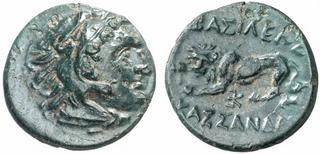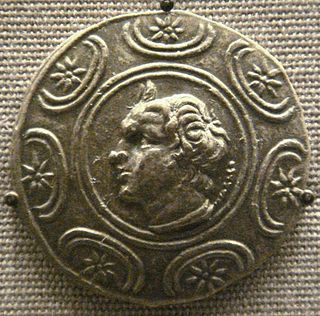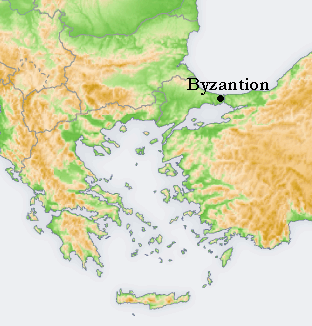This article concerns the period 319 BC – 310 BC.
Year 311 BC was a year of the pre-Julian Roman calendar. At the time, it was known as the Year of the Consulship of Brutus and Barbula. The denomination 311 BC for this year has been used since the early medieval period, when the Anno Domini calendar era became the prevalent method in Europe for naming years.

Demetrius I Poliorcetes was a Macedonian Greek nobleman and military leader who became king of Asia between 306 and 301 BC, and king of Macedon between 294 and 288 BC. A member of the Antigonid dynasty, he was the son of its founder, Antigonus I Monophthalmus, and his wife Stratonice, as well as the first member of the family to rule Macedon in Hellenistic Greece.

Seleucus I Nicator was a Macedonian Greek general, officer and successor of Alexander the Great who went on to found the eponymous Seleucid Empire, led by the Seleucid dynasty. Initially a secondary player in the power struggles following Alexander's death, Seleucus rose to become the total ruler of Asia Minor, Syria, Mesopotamia, and the Iranian plateau, assuming the title of basileus (king). The Seleucid Empire was one of the major powers of the Hellenistic world, until it was overcome by the Roman Republic and Parthian Empire in the late second and early first centuries BC.

Antigonus I Monophthalmus was a Macedonian Greek general and successor of Alexander the Great. A prominent military leader in Alexander's army, he went on to control large parts of Alexander's former empire. He assumed the title of basileus (king) in 306 BC and reigned until his death. He was the founder of the Antigonid dynasty, which ruled over Macedonia until its conquest by the Roman Republic in 168 BC.

Cassander was king of the Ancient Greek kingdom of Macedonia from 305 BC until 297 BC, and de facto ruler of southern Greece from 317 BC until his death.

Antigonus II Gonatas was a Macedonian Greek ruler who solidified the position of the Antigonid dynasty in Macedon after a long period defined by anarchy and chaos and acquired fame for his victory over the Gauls who had invaded the Balkans.

The Wars of the Diadochi or Wars of Alexander's Successors were a series of conflicts fought between the generals of Alexander the Great, known as the Diadochi, over who would rule his empire following his death. The fighting occurred between 322 and 281 BC.

The naval Battle of Salamis in 306 BC took place off Salamis, Cyprus between the fleets of Ptolemy I of Egypt and Antigonus I Monophthalmus, two of the Diadochi, the generals who, after the death of Alexander the Great, fought each other for control of his empire.
The Battle of Paraitakene was fought in 317 BC, during the second of the succession wars that were fought after the death Alexander the Great; the so called Wars of the Diadochi. In Paraitakene, a district of Persis, the armies of Antigonus Monophthalmus and Eumenes the Cardian engaged in a long and bloody battle that ended indecisive; since Antigonus suffered the most casualties the battle is seen as a victory for Eumenes. Both armies withdrew after the battle; Antigonus towards his ally Peithon's satrapy of Media, Eumenes towards Gabiene.

Battle of Gabiene was the second great battle between Antigonus Monophthalmus and Eumenes, two of Alexander the Great's successors. The battle was fought near Gabiene in Persia in the winter of 316-315 BC and ended the Second War of the Diadochi. It established Antigonus as the most powerful of the successors.
Telesphorus was a nephew and a general in the service of Antigonus Monophthalmus, the ruler and later king of the Asian half of the empire conquered by Alexander the Great, who was sent by him in 312 BC, with a fleet of fifty ships and a considerable army to the Peloponnese, to oppose the forces of Polyperchon and Cassander. At first he was very successful; he drove Polyperchon’s garrisons from all the cities of the peninsula, except Sicyon and Corinth, which were held by Polyperchon himself; but having joined with Antigonid admiral Medius in an attempt to relieve Oreus on Euboea, to which Cassander had laid siege, he was beaten back, with the loss of several ships. The following summer, Antigonus having conferred the chief direction of the war in the Peloponnese upon his other nephew Ptolemy, Telesphorus was so indignant that he shook off his allegiance, and having induced some of his soldiers to follow him, established himself in Elis on his own account, and even plundered the sacred treasures at Olympia. He was, however, soon after, induced by Ptolemy to submit. Antigonus must have forgiven him because a few years later Telesphorus was on the staff of Demetrius, Antigonus’ son.
The Babylonian War was a conflict fought between 311–309 BC between Antigonus I Monophthalmus and Seleucus I Nicator, ending in a victory for Seleucus. This conflict ended any possibility of restoration of the former empire of Alexander the Great, a result confirmed in the Battle of Ipsus. The battle also marked the birth of the Seleucid Empire by giving Seleucus control over the eastern satrapies of Alexander's former territory.
Dioscurides or Dioskourides was a nephew of Antigonus I Monophthalmus and admiral during the Wars of the Diadochi.
The Battle of Orkynia was fought in 319 BCE near Orkynia in Cappadocia. It was one of first battles of the wars between the successors to Alexander the Great, the so called Diadochi. At Orkynia the armies of Antigonus Monophthalmus and Eumenes the Cardian met; the battle resulted in a stunning Antigonid victory.
The Battle of Cretopolis (Kretopolis) was a battle in the wars of the successors of Alexander the Great between general Antigonus Monopthalmus and the remnants of the Perdiccan faction. It was fought near Cretopolis in Pisidia in 319 BC and resulted in another stunning Antigonid victory.

The Battle of Byzantium (Byzantion) was a 317 BC engagement between the generals Antigonus Monopthalmus and Cleitus the White, during the Second War of the Diadochi. Fought over the course of two days, near Byzantium at the Hellespont, it resulted in a stunning Antigonid victory.
The battle of the 25 of Abu of 309 B.C. in an unknown location between Babylon and Susa, was the decisive and final clash of the Babylonian war. It ended in a Seleucid victory, and the establishment of the Seleucid kingdom.
The battle of the river Tigris was an engagement between the Diadochi Seleucus and the Antigonid general Nicanor, on the southern bank of the river Tigris in the year 311 BC. Nicanor was on route to recapture the city of Babylon from Seleucus, but he was defeated when Seleucus surprised him with an assault on his camp during the night, forcing Antigonus to cease hostilities with the other Diadochi, in order to concentrate his efforts on recapturing the city of Babylon himself.
The Second siege of Babylon took place during the Babylonian War in 310 BC. Antigonid forces under Antigonus's oldest son, Demetrius, besieged the Seleucid garrison of the city of Babylon under the command of Patrocles.







